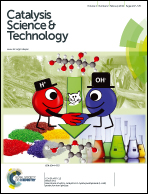An insight into the kinetics and interface sensitivity for catalytic ozonation: the case of nano-sized NiFe2O4
Abstract
In this paper, the kinetics and interface sensitivity of nano-sized magnetic NiFe2O4 in incomplete catalytic ozonation were investigated in detail. By analyzing the kinetics of heterogeneous reactions, it was found that both the degradation of phenol and the decomposition of molecular ozone appeared to follow a first order kinetics model and the presence of nano-NiFe2O4 significantly enhanced these processes. The kinetics equations and reaction rate constants were determined according to experimental results. In light of the IR spectra, the Lewis acid sites were further confirmed as reactive centers for catalytic ozonation in the aqueous phase, and the reason for deactivation of the NiFe2O4 nanocatalyst during incomplete ozonation of organic compounds was determined. The catalytic activity of the NiFe2O4 nanocatalyst could be completely recovered by calcination and ozonation methods, which makes it an attractive nanomaterial with prospective applications in water treatment. According to the interface sensitivity of ozone in water, a strong interaction between ozone and NiFe2O4 was observed and the role of water was revisited. Water molecules were clarified as two different types: one is chemisorbed water on the catalyst surface and the other is bulk water in aqueous solution. Both bulk and chemisorbed water molecules should be weak competitors compared with ozone, and the chemisorbed water on the catalyst surface was proposed not as an inhibitor but an accelerator for catalytic activity.


 Please wait while we load your content...
Please wait while we load your content...